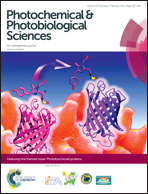A steady-state and time-resolved photophysical study of CdTe quantum dots in water
Abstract
The exciton generation and recombination dynamics in semiconductor nanocrystals are very sensitive to small variations in dimensions, shape and surface capping. In the present work CdTe quantum dots are synthesized in water using 3-mercaptopropionic acid and 1-thioglycerol as stabilizers. Nanocrystals with an average dimension of 4.0 ± 1.0 and 3.7 ± 0.9 nm were obtained, when 3-mercaptopropionic acid or 1-thioglycerol, respectively, was used as a capping agent. The steady-state characterization shows that the two types of colloids have different luminescence behavior. In order to investigate the electronic structure and the dynamics of the exciton state, a combined study in the time domain has been carried out by using fluorescence time-correlated single photon counting and femtosecond transient absorption techniques. The electron–hole radiative recombination follows the non-exponential decay law for both colloids, which results in different average decay time values (of the order of tens of nanoseconds) for the two samples. The data demonstrate that the process is slower for 1-thioglycerol-stabilized colloids. The ultrafast transient absorption measurements are performed at two different excitation wavelengths (at the band gap and at higher energies). The spectra are dominated in both types of samples by the negative band-gap bleaching signals although transient positive absorption bands due to the electrons in the conduction band are observable. The analysis of the signals is affected by the different interactions with the defect states, due to ligand capping capacities. In particular, the data indicate that in 1-thioglycerol-stabilized colloids the non-radiative recombination processes are kinetically more competitive than the radiative recombination. Therefore the comparison of the data obtained from the two samples is interpreted in terms of the effects of the capping agents on the electronic relaxation of the colloids.


 Please wait while we load your content...
Please wait while we load your content...